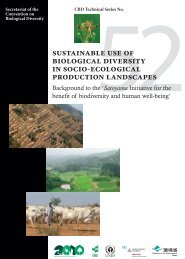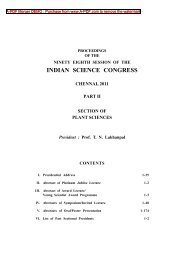Addressing Emissions From Coal Use in Power Generation ...
Addressing Emissions From Coal Use in Power Generation ...
Addressing Emissions From Coal Use in Power Generation ...
You also want an ePaper? Increase the reach of your titles
YUMPU automatically turns print PDFs into web optimized ePapers that Google loves.
Congressional Policy Brief 5<br />
are <strong>in</strong> operation around the world; however,<br />
several new coal-fueled IGCC power plants are<br />
<strong>in</strong> various stages of development <strong>in</strong> the United<br />
States and elsewhere. 17<br />
The <strong>in</strong>cremental cost of CCS varies depend<strong>in</strong>g<br />
on parameters such as the choice of capture<br />
technology, the percentage of CO 2<br />
captured, and<br />
the type of coal used as fuel. As just one example,<br />
a 2007 study by researchers at Carnegie Mellon<br />
University estimated that, compared to an IGGC<br />
plant without CCS, an IGCC plant built with<br />
CCS that captured 90 percent of CO 2<br />
emissions<br />
would produce electricity at a 42 percent higher<br />
levelized cost and reduce GHG emissions at a<br />
cost of $32 per metric ton of CO 2<br />
avoided. 18<br />
However, one should consider CCS cost estimates<br />
from eng<strong>in</strong>eer<strong>in</strong>g studies <strong>in</strong> light of the recent<br />
escalation <strong>in</strong> and uncerta<strong>in</strong>ty regard<strong>in</strong>g capital<br />
costs <strong>in</strong> the power sector. 19, 20 New coal-fueled<br />
power plants (PC or IGCC) can be designed to<br />
<strong>in</strong>corporate CCS from the start of their operation,<br />
and exist<strong>in</strong>g plants can be retrofit for CCS.<br />
Retrofitt<strong>in</strong>g exist<strong>in</strong>g plants leads to higher costs<br />
for CCS compared to build<strong>in</strong>g new plants to<br />
<strong>in</strong>corporate CCS from the start s<strong>in</strong>ce new<br />
plants designed for CCS can optimize their<br />
configuration for the additional equipment,<br />
processes, and energy necessary for CCS.<br />
The<br />
Captured CO 2<br />
must be transported from<br />
its source to a storage site. Pipel<strong>in</strong>es like those<br />
used for natural gas present the best option<br />
for CO 2<br />
transport. CO 2<br />
pipel<strong>in</strong>es are a proven<br />
technology, and the United States already has<br />
more than 3,000 miles of CO 2<br />
pipel<strong>in</strong>es, mostly<br />
transport<strong>in</strong>g naturally occurr<strong>in</strong>g CO 2<br />
to enhanced<br />
oil recovery operations.<br />
21, 22<br />
most promis<strong>in</strong>g method of CO 2<br />
storage<br />
is <strong>in</strong>jection of CO 2<br />
<strong>in</strong>to deep underground<br />
geologic formations that can ensure safe,<br />
long-term CO 2<br />
retention. The portion of <strong>in</strong>jected<br />
CO 2<br />
likely to rema<strong>in</strong> <strong>in</strong> properly selected geologic<br />
formations is estimated to exceed 99 percent over<br />
1,000 years. 23 The United States is fortunate <strong>in</strong><br />
hav<strong>in</strong>g geologic reservoirs with extensive storage<br />
capacity across much of the country. Less is known<br />
about the availability of suitable geologic reservoirs<br />
<strong>in</strong> Ch<strong>in</strong>a, but capacity assessments are underway.<br />
The largest potential for geologic storage <strong>in</strong> the<br />
United States is <strong>in</strong> deep sal<strong>in</strong>e formations, which<br />
are underground porous rock formations <strong>in</strong>fused<br />
with br<strong>in</strong>e; other options for geologic storage with<br />
lower storage capacity are depleted oil and gas<br />
reservoirs and unm<strong>in</strong>eable coal seams (see Table 3).<br />
Table 2<br />
Plant<br />
Installation<br />
Pre-1970<br />
1970-1989<br />
1990-2003<br />
Exist<strong>in</strong>g U.S. <strong>Coal</strong>-Fueled <strong>Power</strong><br />
Plant Fleet by V<strong>in</strong>tage<br />
Capacity<br />
GW<br />
109<br />
194<br />
12<br />
Table 3 U.S. Geologic CO2 Storage<br />
Capacity Estimates<br />
Storage Type<br />
Oil and Gas Reservoirs<br />
Unm<strong>in</strong>eable <strong>Coal</strong> Seams<br />
Deep Sal<strong>in</strong>e Formations<br />
Total<br />
Efficiency<br />
%, HHV<br />
28<br />
36<br />
39<br />
Notes: MtCO 2<br />
= 1 million metric tons of CO 2<br />
.<br />
HHV = higher heat<strong>in</strong>g value.<br />
Source: Kuuskraa and Dipietro 24<br />
CO 2<br />
<strong>Emissions</strong><br />
MtCO 2<br />
/Yr<br />
Billion metric tons CO 2<br />
Low High<br />
80<br />
150<br />
920<br />
1,200<br />
600<br />
1,280<br />
70<br />
CO 2<br />
Intensity<br />
MtCO 2<br />
/MWh<br />
1.16<br />
0.90<br />
0.83<br />
80<br />
180<br />
3,400<br />
3,600<br />
Source: NETL, Carbon Sequestration Atlas of the United States and<br />
Canada, 2007.

















